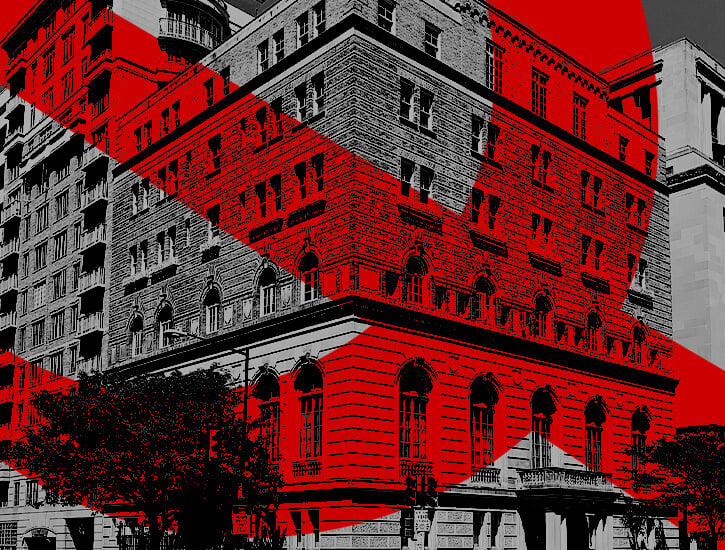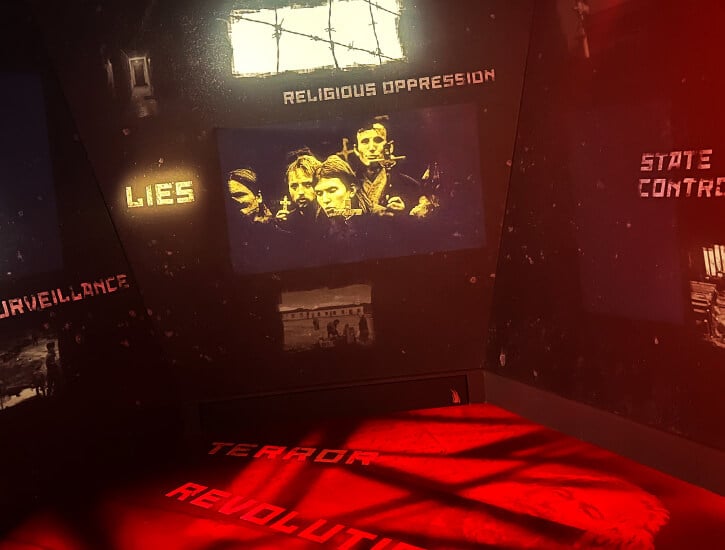Red Scared

“There is no way he is a victim of communism,” my partner quips, pointing to a photo of the late Pope John Paul II. We are near the end of our visit to the new Victims of Communism Museum, standing in an elevator-size lobby with photographs of “victims” screen-printed all over the walls. Among the many victims and honorees: Chinese artist Ai Weiwei, the Dalai Lama, Romanian writer Herta Müller, Hong Kong activist Joshua Wong, and Hungarian neofascist Viktor Orbán.
These public figures are the latest faces of a long campaign to flip the historical script. Ai Weiwei, among the highest-selling artists in the world, has earned his keep resolutely opposing the Chinese Communist Party. Meanwhile, Orbán’s vocal denunciations of Soviet occupation helped launch a political career filled with what critics call “pure Nazi speech.” Despite the cognitive dissonance of this display—Müller’s father served in the Waffen-SS, for god’s sake—the strategy allows the decades-old Victims of Communism Memorial Foundation to position all anti-communists as renegade freedom fighters regardless of their fascist associations, thus rebranding its Holocaust revisionism anew. What better destination for their new museum than Washington, D.C., just one mile away from the U.S. Holocaust Memorial Museum?
Originally founded during the Clinton era by a unanimous act of Congress, the Victims of Communism Foundation is a relic of Cold War-era propaganda. Its central belief that communism has claimed “more than 100 million” victims was lifted from The Black Book of Communism, a controversial piece of Western agitprop that has since been delegitimized by its own contributors. The book, as well as the foundation, peddle the spurious notion that a “double genocide” took place in the twentieth century: one by fascists and another by so-called “Judeo-Bolshevik Communists.”
According to the Victims of Communism team, all Nazis killed by Soviets are victims of communism, as are all deaths resulting from Covid-19. Inside the museum, Mao Zedong figures as a “mass murderer,” but Adolf Hitler is nowhere to be found. Vladimir Lenin and Joseph Stalin, too, are portrayed as running authoritarian, anti-democratic regimes, yet British colonialism and American imperialism garner nary a mention. Hardly anywhere in the foundation’s documents, or in the museum, are Nazis, fascists, royals, colonizers, or capitalists portrayed as aggressors. In fact, World War II isn’t even included in the museum’s timeline.
This kind of hyperbolic revisionism meets roadside tourist trap is capitalist projection at its finest.
Is now a good time to mention that the Victims of Communism Foundation’s original co-chairman, Yaroslav Stetsko, once led the Organization of Ukrainian Nationalists to ally with Nazi Germany alongside Stepan Bandera, who is now a national hero of Ukraine? Not only does the foundation count Nazi sympathizers among its scant few donors, but many other immortalized “victims” were involved in the deportation and extermination of Jews, Poles, Roma, Serbs, Belarusians, and Ukrainians on behalf of Nazi puppet regimes across Europe. I went into the museum expecting to see the usual suspects among the victims—from Holocaust perpetrators Ante Pavelić and Roman Shukhevych to the kulaks and Cuban plantation owners—but was surprised to find the vaunted list has gotten a facelift. Perhaps they hope to attract a new generation of culture warriors, or just far-right trolls with Turning Point USA aspirations.
After more than an hour wandering around the building, I was left deeply unsure what, in their view, even constitutes a “victim” of communism, let alone a “communist.” No one will walk out of this institution knowing much more than some fudged numbers and fashy buzzwords. This kind of hyperbolic revisionism meets roadside tourist trap is capitalist projection at its finest, an alternative history built by dark money and reinforced by disinformation. Nonetheless, considering how much the art world masks its own regressive politics, an unabashed right-wing exhibition of this magnitude is a genuine treat for sickos like me.

Part fascist propaganda, part Epcot ride, the Victims of Communism “museum” is actually just three claustrophobic rooms of dystopian imagery and haunted house sounds, all designed to shock and appall. Tickers run at the bottom of screens endlessly tallying “victims,” while jump-cut documentary footage rushes between shots of Cuba, China, Poland, and Hungary. Along the floors and walls, the words WAR, REVOLUTION, and TERROR pop out against deep shades of black and crimson. LIES, one placard announces near an illuminated image of Eastern European Christians holding crosses. RELIGIOUS OPPRESSION, reads another, juxtaposed with stock imagery of barbed wire.
I can only describe the videos in this place as Ken Burns documentaries from hell. The first begins once visitors trigger a foot plate, enhancing the venue’s dungeon-esque quality. Then a series of jagged screens light up, interspersing photographs of Lenin, Trotsky, and Tsar Nicholas with an ominous, staccato orchestral score. Rather than address the complex historical conditions leading up to the October Revolution, our humble narrator goes straight for the gold: “Reformers hoped for a democratic solution—the Bolsheviks had another idea.”
It was hard for me not to burst out laughing at this appeal to Menshevik supremacy, but I held my cool, lest I offend the solitary front desk worker—who was, I should add, the only other person in the building. Afterward, I noticed a small glass display that held a first edition of The Communist Manifesto, as well as a Russian newspaper from the day after the Bolsheviks took power. “Marx and Engels’ manifesto gave birth to the world’s most violent regimes,” the nearby text intones. Lenin, too, is accused of single-handedly building the gulags and killing “hundreds of thousands” of Russians, leaving a “blood-soaked legacy” upon his death a few years later. Based on this room alone, one might surmise that communism is an individualistic, tyrannical ideology oriented around exploitation.
The Victims of Communism Museum is not the place to find valid critique; it’s a wasteland of thinly veiled bigotry.
Of course, they would be wrong, but no matter to our humble curators; the museum never sets out to define communism in any capacity. In their selective version of history, once upon a time, Marx and Engels wrote an evil little pamphlet, and then—skipping right over the Paris Commune—we find ourselves in 1917 at the start of the Russian Revolution. We then jump, curiously, from Stalin consolidating power in the 1930s to the Cold War and beyond. These glaring gaps in history feel intentional in the displays devoted to starvation and imprisonment, in which Soviet gulags take precedence, but Nazi concentration camps are nowhere to be found.
A related video juxtaposes the gulags with prisons in Vietnam, China, Korea, and Cuba. Paintings and sketches made by detainees are interwoven with quotes from Nobel laureate Aleksandr Solzhenitsyn (a favorite of Steve Bannon and Jordan Peterson). Hearing the words of prisoners and experiencing their art, I was somewhat moved by the concept of creative resilience in confinement, particularly given the brilliant work produced by incarcerated artists here in the States. But it’s hard not to see this as artwashing Nazi war crimes, or what Ljiljana Radonić calls “comparative trivialization.”
By downplaying the Holocaust, the museum can seamlessly move to the Holodomor and Great Leap Forward, two periods of enforced economic reform that they portray as intentional massacres. And with little wall space remaining, they do a speed-run through Vietnam, China, North Korea, and Cambodia, sloppily tying together Juche, the state ideology of North Korea, with the Khmer Rouge. This rhetorical trick, which is hard not to perceive as racist, allows them to gloss over the nuances inherent to these distinct regions while avoiding what happened in Cambodia before Pol Pot took power. (As Anthony Bourdain once said, if you visit Cambodia, you will “never stop wanting to beat Henry Kissinger to death with your bare hands.”) In a final video, the narrator also claims that Czech protesters from 1968 desired, above all, “democracy and free markets,” rather than the loosening of Soviet control over creative and political forms of expression. As it ended, my gaze fell on a nearby wall photograph showing an East German guard fleeing to West Berlin, which is credited to the CIA.
Toward the exit, an interactive choose-your-own-adventure game allows visitors to reflect on all this “information” as a Cuban, Korean, or German individual. Two paths can be chosen on the screens provided: in the first, you comply with a newly appointed communist government, while the other takes you on the dissident path. No matter which path I chose, however, my protagonist ended up compromised—either by facing persecution or bringing shame on my legacy. The framing is utterly nihilistic, a downward spiral resulting in entrapment no matter the response. In many ways, it resembles how people describe getting arrested in the United States.
Before going any further, I should clarify a few things. I don’t doubt the existence of persecution and suffering in communist countries. I’m well aware of the mortal consequences of agrarian reforms in China and Russia, as well as the problems of absolute power. But the Victims of Communism Museum is not the place to find valid critique; it’s a wasteland of thinly veiled bigotry. Their fast-and-loose analysis feeds into a far-right strategy to whitewash imperial, feudal, and fascist histories, developed at a time when Western countries welcomed former Nazis into top-brass positions. Moreover, selectively lifting stats from long-debunked sources only further promotes disinformation; for an example, look no further than the “horrors of socialism” resolution recently passed in the House, which parrots the “100 million victims” statistic.
Communists are simultaneously to blame for Covid-19, as well as for lockdowns, but please do remember to wash your hands!
Undercutting all of this, of course, is the role that Western powers have played in constraining—violently and otherwise—Soviet and Third-World autonomy. Not a single revolution of the twentieth century went without its fair share of trade sanctions, assassination attempts, and disinformation campaigns. Rather than focusing on building a new society, revolutionary movements have always been forced on the defensive—and even still, freedom of art flourished in the well-funded Soviet film industry, and Vietnam successfully ousted its occupiers. Should we really be taking what Holocaust revisionists claim about China, Cuba, and elsewhere today at face value?
Conflating communism with fascism—while conveniently eliding the horrors carried out by its own fascist honorees—is old hat for this foundation, and the museum treads well-worn territory. Curiously, many of the foremost “victims” are men, and few are Black. I almost have to admire their attempts to tiptoe around slavery and identity politics, if it weren’t for the number of Black radicals persecuted by and within capitalist countries—from the outright assassinations of Amílcar Cabral and Patrice Lumumba to the persecution of intellectuals like Assata Shakur and Paul Robeson. Of course, even the nightmare fantasies concocted here include a tinge of casual racism, and it’s remarkable they even thought to acknowledge communist revolutions in Africa (albeit in small text near the exit).
As this all makes clear, the museum is not really for anyone who disagrees with conservative doctrine, or even for centrists playing both sides; it’s for far-right ideologues who already champion the views espoused here and would like their children to do the same. As with most roadside attractions, every reactionary impulse is thrown to the wall to see what sticks. While Covid-19 is simultaneously a hoax and communist plot, you can still find the Victims of Communism-branded hand sanitizer in its gift shop, along with supposedly real fragments of the Berlin Wall, anti-Che Guevara shirts, bracelets made by a Ukrainian jeweler, and—oh my—a Nora D. Clinton book on the perils of quarantining. Communists are simultaneously to blame for Covid-19, as well as for lockdowns, but please do remember to wash your hands!

By now you’ve likely seen the videos of the expansive encampment across from the museum in D.C.’s McPherson Square. Social media posts hardly convey the scale; there are countless tents across multiple city blocks keeping the city’s unhoused population warm through the winter months. “When you step outside the building you conveniently enter the real-time updating Victims of Capitalism Museum,” one astute reviewer noted. While D.C. officials recently cleared the premises—an action endorsed by the entire Washington Post editorial board—I doubt they recognize the irony here.
This is the world the Victims of Communism Foundation seeks to preserve, and the one they also tend to blame on their liberal opponents—who are also, supposedly, all communists. Coincidentally, the museum is located in the United Mine Workers of America Building where, as Mike Davis has written, union leader John L. Lewis notoriously banned communists and imposed top-down leadership to limit local autonomy. Much like Lewis, the museum’s goal is to obfuscate, yet for anyone with a working smartphone, much of it can easily be written off. At the same time, Eastern European countries like Hungary, Lithuania, and Latvia have all passed laws criminalizing opposition to the “double genocide” claims, so maybe the propaganda really is working.
For now, the Victims of Communism Museum continues its mission uninterrupted—or at least from 9:00 a.m. to 3:00 p.m., five days a week—all while its foundation still receives donations from fascist sympathizers across Eastern Europe and the Balkans. As recently as 2021, they installed a controversial memorial in Ottawa entirely with private funding. Rather than name victims on the memorial, the foundation instead listed the monument’s moneyed donors. Perhaps letting people Google victim names might get them into trouble again. At the very least, Canadian media remains skeptical.
“Terror is an absolute necessity during times of revolution,” a quote from Soviet officer Felix Dzerzhinsky reads on one wall back in the museum. True enough, but terror for whom? For the profiteers of state terror at home and abroad? Or enslavers of the prison-industrial complex who sit on museum boards? I fail to see what Mao or Stalin could do beyond the grave to significantly impact my life, but I can see how white nationalism threatens my agency. I can see that by flipping the script, fascists quickly transform into freedom fighters, and thus the severity of slavery and extrajudicial killing in capitalist countries become mere matters of opinion. Such sore winners will never be happy until every last speck of land is open for extraction—and even then, it still won’t be enough.
But, hey, don’t just take my word for it! Listen to the voices of their workers—or, if you will, the Victims of the Victims of Communism Foundation. One woman who worked there for a few months notes that “sexist and conservative management” contributed to a “toxic work environment.” Another employee claims that anyone who is not a “staunch conservative” will be “extremely uncomfortable” with management’s daily discussions and that employees are not allowed to “openly voice concerns.” While none of this sounds surprising for a U.S. nonprofit, it does speak volumes about an institution that claims to be on the right side of authoritarianism—turns out they’re just on the right.